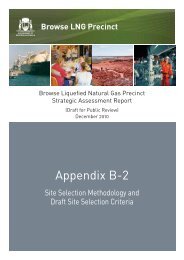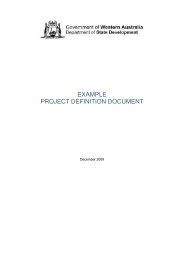Browse LNG Precinct - Public Information Booklet - Department of ...
Browse LNG Precinct - Public Information Booklet - Department of ...
Browse LNG Precinct - Public Information Booklet - Department of ...
Create successful ePaper yourself
Turn your PDF publications into a flip-book with our unique Google optimized e-Paper software.
<strong>Public</strong> <strong>Information</strong> <strong>Booklet</strong><br />
The jetty is likely to be built using piles anchored to the seabed into the rock. The spacing<br />
and number <strong>of</strong> piles will depend on the final configuration <strong>of</strong> the jetty. The requirement for<br />
piles will be broadly similar for both north and south <strong>of</strong> James Price Point options.<br />
Marine Facilities<br />
Question ñ What type <strong>of</strong> jetty will there be and what is the expected size?<br />
The jetty design is influenced by the geological and seabed conditions and the distance<br />
to deep water. Differences in the marine environment to the north and south <strong>of</strong> James<br />
Price Point are very significant and will influence the concept that is adopted.<br />
Each proponent would have its own jetty. This is driven by:<br />
� Safety considerations from events that could occur due to another operator;<br />
� Uncertainty over the jetty design requirements for future proponents.<br />
A single jetty for three berths is sufficient to meet the foundation proponentís<br />
requirements. The export <strong>of</strong> 50 million tonnes per annum <strong>of</strong> <strong>LNG</strong> from the <strong>Precinct</strong> will<br />
require six berths, and the number <strong>of</strong> jetties will be dependent on the number <strong>of</strong><br />
proponents.<br />
If a jetty structure is used it is likely to be an open trestle structure supported on driven<br />
steel piles anchored into the rock below the seabed. The height <strong>of</strong> the jetty will be set to<br />
avoid overtopping in any cyclone or other extreme event. The jetty itself will provide a<br />
single traffic lane and a series <strong>of</strong> pipelines for <strong>LNG</strong> and condensate loading as well as<br />
return gases and vapours.<br />
A key focus for the port and jetty design will be to minimise the footprint/area required<br />
(particularly for the coastal crossing) as far as practicable.<br />
5279225 62









